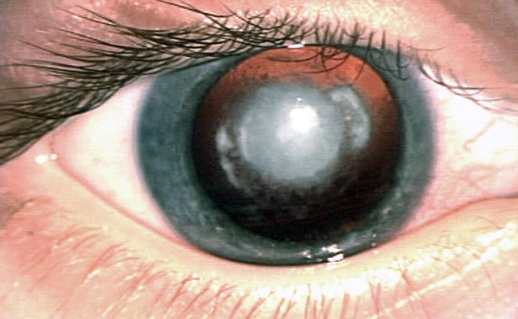The cataract is usually recognized as a whitish blur in the center of the pupil of one or both of the child’s eyes.
Unilateral cataract , Bilateral cataracts
The cataract is usually recognized as a whitish blur in the center of the pupil of one or both of the child’s eyes. Generally it is easy for the parents to see it when they look at the child’s eyes or look at photographs, wherein the one or the two pupils do not seem to have the expected clarity with its characteristic rosy complexion.

Congenital cataract as it is shown to a child after having mydriasis (pharmaceutical pupil dilation)
Unilateral cataract
In half of the cases of children with cataract infestation is unilateral.
Although, in theory at least, the unilateral cataracts are more easily recognized by the bilateral (due to direct comparison between the two eyes), the recognition of the problem may be delayed, particularly in young infants, who have small daughters and keep their eyes closed most of the day.
Children with unilateral cataract may appear to have a normal vision, but this is due to the good sight of the other eye. Also, if the eyes have a good cooperation, recognition of the problem from parents or the pediatrician becomes even more difficult.
The most common reason leading to the discovery of a childhood cataract is the appearance of strabismus in the eye. If the eye does not see well because of the blurring, it usually does not retain alignment with the healthy eye and squints inwardly, outwardly and sometimes upwards. This deviation is often the reason that parents resort to an ophthalmologist, where finally cataract is diagnosed.
In older children, the diagnosis of cataract comes from testing the visual acuity when in kindergarten or elementary school, where the eye with cataract shows a significant reduction of vision.
Bilateral cataracts
If the cataract is in both eyes, it may be more difficult to be recognized by the contralateral cataract, since there is no comparison criterion of the two eyes, which will initiate suspicion that something is not well with one of the child's eyes.
The first sign is often derived from the child's behavior, which seems to avoid looking his parents in the eyes or respond to gestures and smile with their games.
Older children may have difficulty in identifying familiar objects, or they keep them very close so they can see them. Also moving around in the room can be problematic, since they don’t see well so they hit the scattered toys or furniture in the room.
Still, in other cases the first point of a bilateral cataract is nystagmus.
 German
German Ελληνικά
Ελληνικά